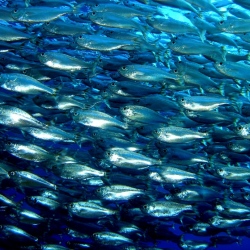
A research team has published the results of an ocean iron fertilization experiment (EIFEX) carried out in 2004 in the current issue of the journal Nature. EIFEX has shown that a substantial proportion of carbon from the induced algal bloom sank to the sea floor.
These results, which were thoroughly analysed before being published now, provide a valuable contribution to our better understanding of the global carbon cycle. Over 50 per cent of the plankton bloom sank below 1000 metre depth indicating that their carbon content can be stored in the deep ocean and in the underlying seafloor sediments for time scales of well over a century.
Iron Fertilization helps restore fish populations. In 2012, the distribution of 120 tons of iron sulfate into the northeast Pacific to stimulate a phytoplankton bloom which in turn would provide ample food for baby salmon. The verdict is now in on this highly controversial experiment: It worked.
In fact it has been a stunningly over-the-top success. This year, the number of salmon caught in the northeast Pacific more than quadrupled, going from 50 million to 226 million. In the Fraser River, which only once before in history had a salmon run greater than 25 million fish (about 45 million in 2010), the number of salmon increased to 72 million.
The cost for iron fertilization would be “ridiculously low” as compared with any other possible method of carbon sequestration. Quite seriously, all you need to do is throw rubbish over the side of the ship to make it happen.
No, really: ferrous sulphate is a waste product of a number of different industrial processes (if I’m recalling correctly, one source would be the production of titanium dioxide for making white paint, a large industry) and it really is a waste. It gets thrown into holes in the ground.
